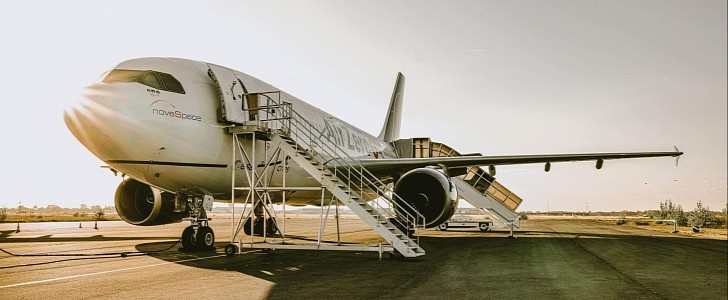Aerial refueling is an essential capability that’s widely used by military forces for their fighter jets, but it’s still not possible to replicate when it comes to spacecraft. However, the German Space Agency at the German Aerospace Center (DLR) is still working on it. In-orbit refueling was one of the experiments carried out over the past three days inside the Airbus A310 ZERO-G.
Scientists have figured out a long time ago a way to carry out space-related experiments without actually going to space. Parabolic flights were established back in the 1950s, allowing aircraft to reproduce zero-gravity conditions for short amounts of time. Today, the A310 Zero-G is the biggest aircraft of this kind, in terms of both experiment surface area and passenger capacity.
This flying research platform is operated by the French company Novespace and it’s available for the public as well, not just for scientists. DLR is one of the entities that use the A310 Zero-G regularly and has been conducting parabolic flights for different types of experiments since 1999.
This year, DLR resumed its parabolic flight campaigns in Bordeaux, France, and also added three new exciting experiments to the ones that were conducted in previous campaigns as well.
“Spacebike” is just what it sounds like – making people pedal in spaceflight-like conditions, “Coolfly” is about the effect of refrigerated clothing on the human circulatory system, and the “Zero Boil-Off Tank” is not about physiology, but about increasing the sustainability of spacecraft and satellites.
For the Zero Boil-Off Tank, the filling and transfer of liquid propellants were tested in microgravity conditions. Researchers from the Center of Applied Space Technology and Microgravity (ZARM) at the University of Bremen did that during the parabolic flight. The goal is that someday propellants could be stored and transferred in space, which would extend the life of certain space missions.
The DLR parabolic flight campaign began on August 29 and is ending today, September 8. In addition to the three new experiments, another premiere was the participation of a blogger from Flightradar24.
This flying research platform is operated by the French company Novespace and it’s available for the public as well, not just for scientists. DLR is one of the entities that use the A310 Zero-G regularly and has been conducting parabolic flights for different types of experiments since 1999.
This year, DLR resumed its parabolic flight campaigns in Bordeaux, France, and also added three new exciting experiments to the ones that were conducted in previous campaigns as well.
“Spacebike” is just what it sounds like – making people pedal in spaceflight-like conditions, “Coolfly” is about the effect of refrigerated clothing on the human circulatory system, and the “Zero Boil-Off Tank” is not about physiology, but about increasing the sustainability of spacecraft and satellites.
For the Zero Boil-Off Tank, the filling and transfer of liquid propellants were tested in microgravity conditions. Researchers from the Center of Applied Space Technology and Microgravity (ZARM) at the University of Bremen did that during the parabolic flight. The goal is that someday propellants could be stored and transferred in space, which would extend the life of certain space missions.
The DLR parabolic flight campaign began on August 29 and is ending today, September 8. In addition to the three new experiments, another premiere was the participation of a blogger from Flightradar24.







